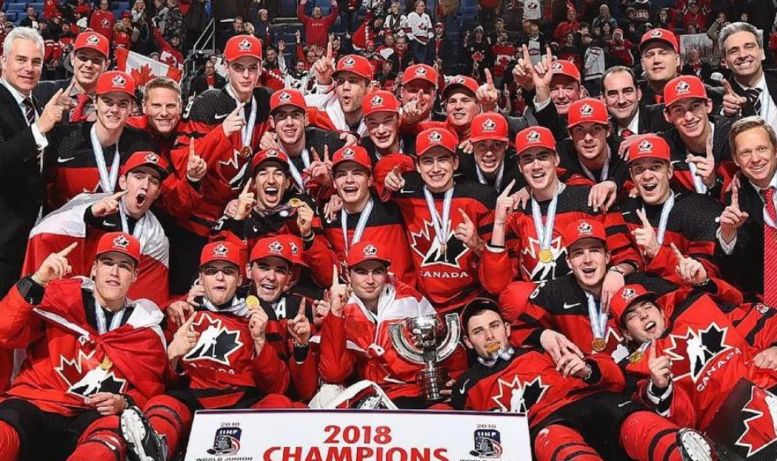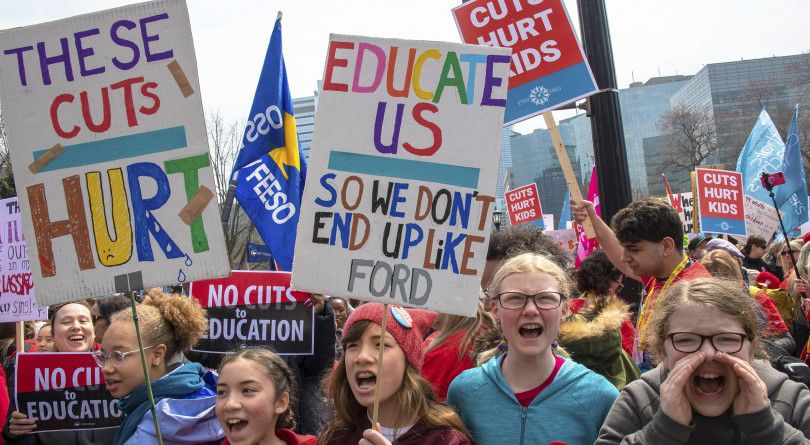Women must be safe in and around sports
Women in hockey have made major strides forward in the past decade. Canada’s national women’s and girls’ teams continue to regularly win international trophies, the percentage of girls enrolling in youth hockey is increasing along with other sports, and women have broken through into the ranks of National Hockey League management and broadcasting. (One continued and major shortcoming is the failure to establish a solid and stable women’s professional league, in part due to the NHL’s disinterest.)
But in spite of these gains, there is a very difficult and long road yet to travel before misogyny is rooted out of the game and its culture. The revelations around Hockey Canada (as well as similarly dire stories from the worlds of Canadian soccer and gymnastics) over the past several months reinforce this truth in an especially brutal way.
Sports broadcaster TSN reported in May of this year that Hockey Canada, the national body in charge of Canadian amateur hockey from the first organized leagues of five- and six-year-olds all the way up to major junior hockey international tournaments, had quietly paid a settlement to a victim of an alleged 2018 sexual assault committed by eight Canadian Hockey League (CHL) players, some of whom were members of that year’s World Junior Hockey Championship (WJHC)-winning Canadian men’s national junior (under-20) team.
The public outcry, further fed by subsequent exposures of additional cover-ups and shielding of offenders going back decades, has brought forth a real opportunity to win long-needed and fundamental changes to sport in this country. Sports fans and socialists (and those of us who are both) must both understand what led to this point, and also raise the question: from the ashes of Hockey Canada, what must be built, both organizationally and culturally?
The story so far
TSN and then The Globe and Mail‘s spring and early summer reporting uncovered that Hockey Canada had agreed to an undisclosed settlement with a young woman, known publicly only as E.M., who was 20 years old at the time of a Hockey Canada golf fundraiser in London, Ontario in June 2018. Her April 2022 lawsuit against Hockey Canada, the CHL (the umbrella organization for Canada’s three major junior hockey leagues) and eight unnamed players is a story of predation that too many women will feel an immediate dread in hearing. The suit states in part that she was encouraged to drink heavily at a London bar with players and then agreed to go to the hotel room of one of them. After the two of them engaged in sex, which E.M. called consensual in spite of her inebriation, that player — referred to as “John Doe 1” in court documents — then invited John Does 2 through 8 into the room where they sexually assaulted E.M.
The London Police Service (LPS) investigation seems to have been on a par so many other sex crimes: some cursory interviews followed by a throwing up of the hands and a declaration, in essence, that there’s just no way to get to the bottom of things when one side says an assault took place and the other side says the opposite. E.M. went to police headquarters on June 22, three days after her ordeal, and on June 24 informed them that she wanted to pursue criminal charges. She spoke again with police in August of that year. But then in February 2019, LPS told her that they would be dropping the investigation.
E.M.’s civil lawsuit was settled on May 20, 2022 and the story broke to the public two days later to immediate and continued popular outrage. After the initial furor from the London revelations, police in Halifax then announced that they were also reinvestigating an alleged 2003 sexual assault, in which players from that year’s Canadian men’s junior team were accused of a similar group sexual assault around the time the WJHC was being held in that city.
In the meantime, the existence of a “National Equity Fund” was made known, largely funded by registration fees from young players across the country. Before the settling of E.M.’s case, this slush fund had already supplied most of the $8.9 million paid out to sexual assault survivors in 21 mostly quietly resolved instances dating back to 1989. The majority of this money was used in the case (well-publicized unlike most of the rest) of Graham James, the former major junior coach who sexually assaulted at least six of his male players in the 1980s and 1990s. Countless hockey parents were enraged that the ever-increasing registration fees, paid so their children could participate in sport and have safe fun, were essentially being transformed into hush money. Many decided to withdraw their children from the organized game entirely, including some who did not want to see their young boys risk becoming the kind of young men who would commit such crimes as were being reported.
Was the plan of Hockey Canada’s board in the wake of all this — charged as they are with the safety of those in and around the game of hockey — to get to the truth of the matter and foster open debate about the changes needed to drive sexist acts and attitudes out, and how to achieve those changes?
No, their goal was to hang on with both hands to their prestigious positions — and the free trips, banquets, jewellery, and other perks that came alongside. This was exemplified with absolute plainness by the performance given by Hockey Canada’s interim chair Andrea Skinner at the House of Commons Standing Committee on Canadian Heritage on October 4. One of her most particularly cynical talking points that day was that Hockey Canada’s burial of the story was done not for the reputation of the organization or its players, but out of concern for the victim and the pain and abuse she would have to endure from a trial. Using the latest in corporate-appropriated social-justice-type language, “our instinct was one of compassion for the young woman and a sincere desire to respect her wishes and perspectives,” Skinner told members of the committee. She also described herself as “a lightning rod for extremists,” though just what “extreme” views (presumably in defence of a sexual assault survivor) she had encountered remained a mystery. And she declared, when asked how she would grade Hockey Canada CEO Scott Smith’s performance over the course of the investigations, “I’m a hard marker and I think that the circumstances in which Mr. Smith has been working have been really extraordinary and difficult. I would say he’s conducting himself as an ‘A’ in the circumstances.”
Her performance at the committee got a universal “F” and helped only to intensify the pressure on the higher-ups she was so blatantly and ham-fistedly trying to protect. She and they were further buffeted by the uncovering of another slush fund with an even worse name, the “Participants Legacy Trust Fund” — established, seemingly, to protect the legacies of participants in sex crimes. Skinner resigned four days later, and finally the entire Hockey Canada board, including Scott, quit their positions on October 11.
“Will the lights stay on” at Hockey Canada?
Hockey Canada was forced to announce on October 25 that it would not collect a $3-per-player registration fee from the country’s 13 provincial and regional amateur hockey associations this season, after several of these associations announced they would refuse to forward the money. The federal government has also frozen its funding to Hockey Canada. And the federation’s sponsors have been abandoning ship — Canadian Tire, Tim Hortons, Scotiabank, Sobeys, General Motors, Telus, Bauer, and Nike have all announced cancellations or suspensions of their ties with the organization as a whole or its men’s program in particular. This is after the 2022 WJHC in Edmonton (held in August, 7½ months late, due to the omicron wave of COVID-19) was played nearly without sponsors and with greatly reduced attendance, in part due to the unusual timing but also because of fans’ revulsion at the allegations and Hockey Canada’s non-responses.
At the moment, it looks very possible that either or both of public and governmental pressure will force Hockey Canada to declare itself dissolved and that it must be replaced by a new national hockey body. But by what means would a new organization ensure that it doesn’t simply return, at least after the spotlight is turned off, to the same path as its predecessor?
It’s worth remembering that the sponsors who have now left Hockey Canada in droves didn’t do so because of a deep-seated concern for the safety and equality of women, but only after it became clear that Hockey Canada’s public-relations problem wasn’t going to quickly die down, and their brands could become tarnished by continued contact. They or companies like them will come creeping back after sufficient heat has died down, because there are huge profits to be made from commercials, board ads, and various “presented by” broadcast segments. Corporate boardrooms will not be engines of change, and will in fact be an obstacle. Barely more faith can be put into government commissions or parliamentary hearings, whose actors may look to clean house but will adamantly stop short of the sort of change that could reach beyond merely the sports scene.
A new national hockey federation’s leadership should be elected by parents and players aged 16 and older. New policies around safety — on and off the ice — should be openly debated amongst the hockey community at large. The current board’s membership is a mixture of volunteer and highly paid positions, which leads to an unhealthy class dynamic skewed toward the already well-connected and well-off. Board positions should all be paid, but with no one earning more than the average worker’s wage. The priority must be toward the grassroots of the game and making it accessible to all who want to play, breaking down barriers of prejudice and of economic access. Special bodies in the new federation with real teeth should be formed, with as much participation from the affected groups as possible, to address sexism, racism, and LGBTQ-phobia in the dressing room and the stands.
There must also be a larger overhaul in the way sexual assault allegations are investigated. Only 12 percent of reported sexual assaults in Canada result in a conviction and only about 20 percent are brought to a trial. And an estimated 83 percent (federal government statistic) to 94 percent (statistic from Canadian Women’s Foundation) of sexual assaults don’t even get as far as an initial police report. Unfortunately, male hockey players — revered for the glory they can bring to small- and mid-sized cities in their teenage years — are often given carte blanche (or at least a studied look the other way) when it comes to their relations with young women. And the same culture of sexual exploitation and the cone of silence that accompanies it can directly victimize male players as well, especially when they are under the sway of charismatic and manipulative authority figures such as the aforementioned James. This is indeed part of larger societal problems of misogyny and sexual violence which is beyond the ability of one sport to fully eliminate. But hockey has an opportunity to set a new standard here.
Perfectly emblematic of the entitled culture in hockey that needs to end, Skinner made an attempt at a veiled threat in her testimony to the Heritage Committee when she said of any attempt to remove Hockey Canada’s leadership: “I think that will be very impactful in a negative way to our boys and girls who are playing hockey. Will the lights stay on in the rink? I don’t know.” Skinner, Smith, and that leadership are now gone. With the significant public outcry this terrible story has raised, there is a real chance that swift cultural and organizational changes in hockey can be accomplished in the near future if parents and players dedicated to winning real change take an organized lead. For the sake of the game, its participants, and those around it, the lights at Hockey Canada — and on misogyny in sports — must go out for good.




